Winter Garden Escapes in New York City, Part One: A Bridge to Nowhere in the New York Times Building.
This time of year I can’t say spring is right around the corner with any conviction, no matter what the groundhog saw, or not. I long for warmth and more green than my potted plants, limping along anemically after being brought inside for the winter, can provide. In an ideal world I would be able to fly to the southern hemisphere, soak up the late summer sun and visit some great outdoor gardens, but alas, life is less than ideal sometimes. Fortunately, for those of us within striking distance of New York City, the Big Apple offers options for those needing a garden fix that don’t require getting on a plane.
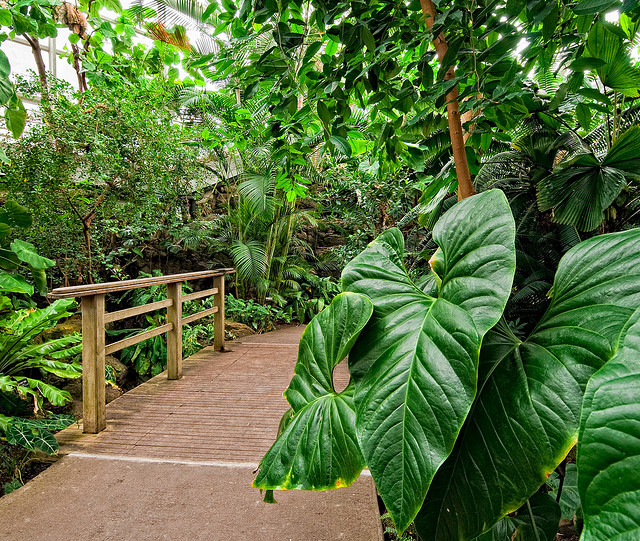
There are a few obvious choices, namely the conservatories at the city’s major botanical institutions, the Brooklyn Botanical Garden, the New York Botanical Garden and Wave Hill. Offering a variety of plants and zones and glass, they will sate the most jungle and succulent-hungry among us. Conservatory at the Brooklyn Botanical GardenThe only drawback is they all require a time commitment if coming from Midtown Manhattan.

My fallback has traditionally been the atrium at the Frick Collection, located on East 70th Street. Atrium at the Frick Collection The large pool in the center of the space lit by an arched skylight above, surrounded by plants, statuary, and columned arcades, offers a luxurious, serene atmosphere. Scarcely a whisper can be heard over the lightly splashing water emanating from the fountain in the middle of the pool and the mouths of bronze turtles along its edges. There are plenty of benches beckoning one to sit, reflect, and soak up the surrounding grandeur. Although never empty, the other people nearby quietly contemplating the art in the halls off the court or passing by into the other galleries are scarcely noticed. The only caveat to enjoying this magical space is that one must pay the museum admission fee to use it. Though a small enough price, I decided to try out some of Gotham’s other indoor gardens for variety’s sake, which might have the added bonus of being free to the public. The three gardens I decided to try out are all located in Midtown Manhattan. They were, The Birch and Fern Forest located in the New York Times Building on 8th Avenue, the Rainforest found in the Atrium of the Ford Foundation’s headquarters on East 43rd Street, and the lobby of the Japan Society, located several blocks north on East 47th Street.
First Stop - The Birch and Fern Garden at the New York Times Building

I was excited to visit this garden. The official literature I received states “ Envisioned by celebrated architect Renzo Piano, and realized by renowned landscape architects M White Site Architects, the garden features a grove of 50-foot-high paper birch trees and an elegant wooden footbridge, creating a calm and serene environment in the middle of one of the densest neighborhoods in the city, at Eighth Avenue and 40th Street, near Times Square.” It goes on to describe the meticulous computer simulations and studies that went into the choosing of the plant material. I had passed by the building before and never realized it held such a treasure inside.
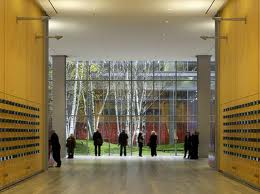
Entering from Eighth Avenue I realized why. To reach the garden you have to go down a corridor, albeit wide, into the center of the building. Though nothing obstructs your passage, it is very similar to the flanking ones providing access to the building’s elevator banks, which are blocked by check-in desks manned by security personnel. For the timid and unknowing, it would be hard to gauge the public access to the sylvan pocket seen at the other end.
As I passed by the gauntlet of security men, I felt compelled to call out“ Just here to check out the garden, I read about it online!” They looked up and nodded benignly. In this era of heightened security and the distinctly corporate atmosphere, I also felt compelled to ask a man behind one of the desks if it was ok to take pictures. He nodded yes, with a smile. Despite all this, I pulled out my camera out and took my pictures hastily, with the uneasy feeling that the privilege could be revoked at any time.
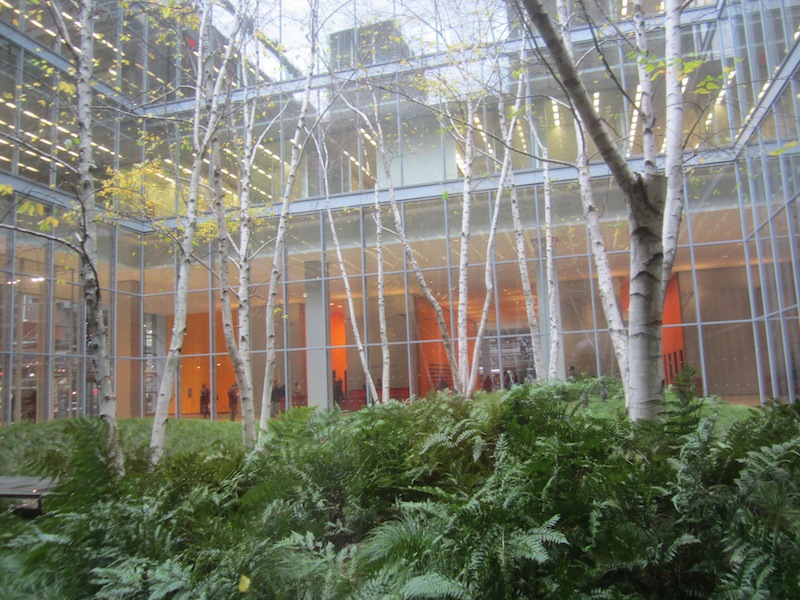
Despite being December 31st, the birch trees in the garden still retained their yellow leaves, pushing back time to the golden days of autumn.
The undulating ground beneath was carpeted with grass and fern. Although there were no benches, a rustic wooden footbridge reminiscent of those found on Fire Island bisected the space, crying to be walked on.
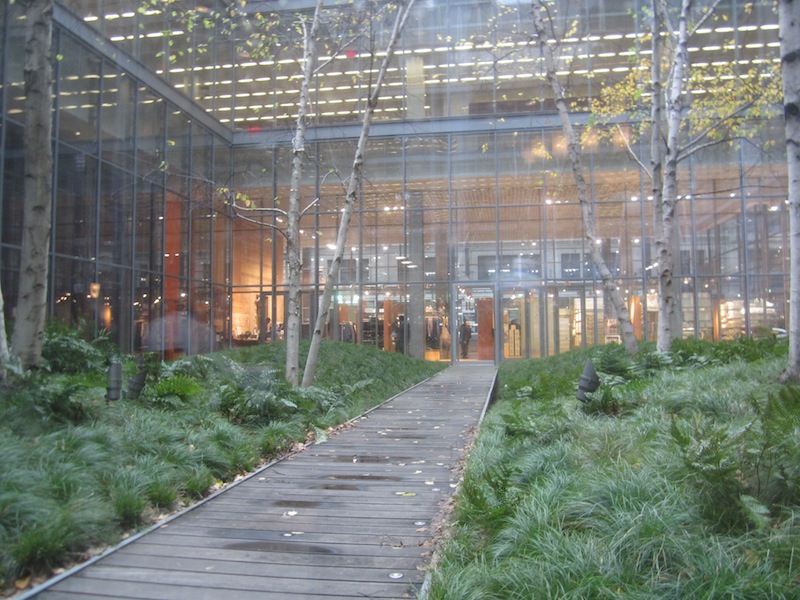
I went to a glass door located at one end of the bridge and tried to go out and found it locked. I walked around and tried the door on the opposite side with the same result. I returned to the desk and asked the man who allowed me to take the photos if the space was closed for the winter.
“It’s not open to the public, just the gardeners can access it”. He replied
That seemed funny, someone designing a beckoning walkway across a space that was never meant to be walked on - a bridge to nowhere in the middle of Manhattan. I remarked to the same man, who was helpfully printing out some literature on the garden for me, that I liked the micro climate inside must be very sheltered, as the leaves were still on the trees. He then leaned in towards me and said conspiratorially
“Actually it’s a bit of a problem in the summer. The reflection off the glass heats the space up so much it causes stress to the trees. They had to replace a couple last year”.
I thanked the man for the literature headed back out to the street and looked back. Inaccessible behind the glass, the garden suddenly looked flat to me, an illuminated backdrop in this office building teeming with human life and activity. While beautiful, there was no engagement of the olfactory or auditory senses, interactivity with the working in the offices surrounding it. Few of the people walking along the glass corridors around the garden, stopped to look at, contemplate, or seemed to notice, this patch of woods, which now appeared trapped in a glass box.
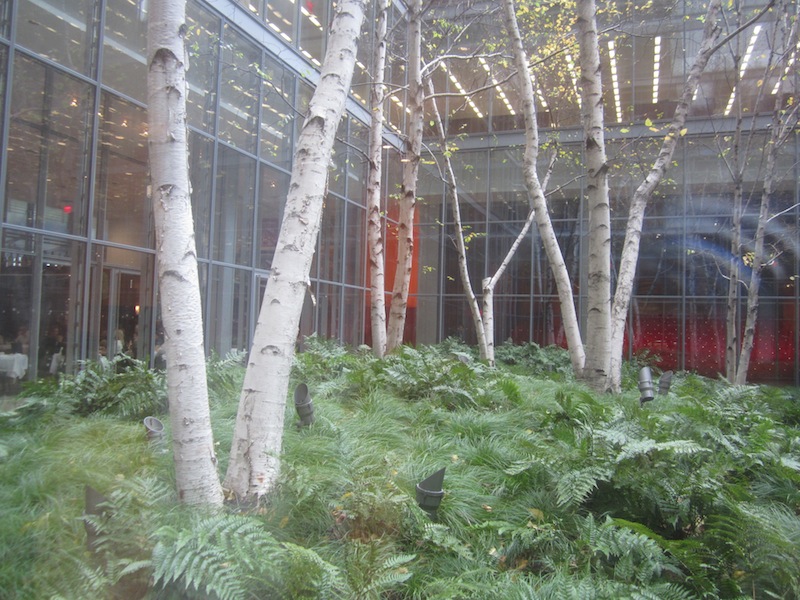
I was hoping to have better luck with my next two stops.
In Part 2: My forays to the Ford Foundation and the Japan Society.



